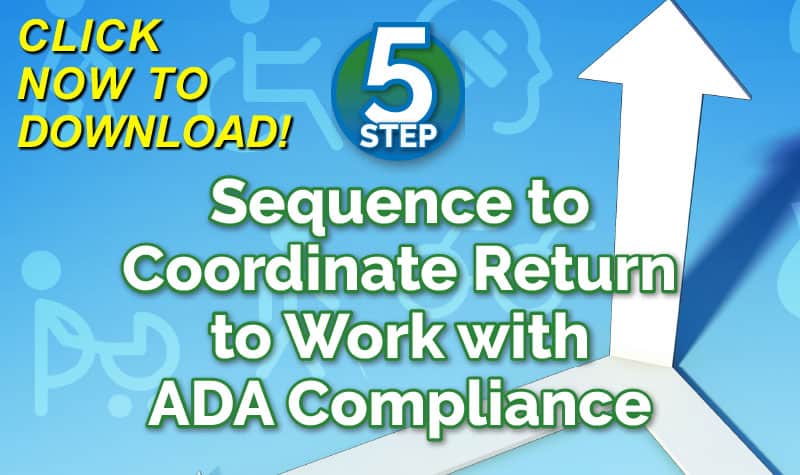
This post is one of a series as a follow up to training:
- ADA – If light duty cannot be accommodated, should FMLA run concurrently?
- ADA – Do All Work Comp Injuries Fall Under the Americans with Disabilities Act Amendments Act (ADAAA)?
- ADA – Is it against the law not to hire a person with a disability for a physical position?
Click Link to Access Free PDF Download
“5-Step Sequence to Coordinate Return-to-Work with ADA Compliance”
A prior training on Return to Work and the ADA initiated the following questions:
- ADA – Questions on Temporary and Permanent Restrictions
- ADA – Reasonable Accommodation And Workers Comp Questions Answered
- ADA – Ensure Interactive Process Compliance, And Other Questions Answered
- ADA – What Happens When An Employee Opposes Return To Work?
- ADA – If No Light Duty Is Available, Can The Employer Terminate Employment?
If a worker is being paid Temporary Total Disability (TTD) because light duty cannot be accommodated, should FMLA run concurrent?
FMLA leave is unpaid time off. However, in lieu of FMLA leave, an employee may take sick days, vacation days or disability leave with pay, unless the employee is receiving workers’ compensation benefits. In that case, the employer cannot require substitution of vacation, sick or other paid leave. If the employer properly designates the workers’ compensation leave as FMLA leave, the absence can be counted against the employee’s 12-week entitlement. Regardless of how many weeks of paid leave an employee decides or is required by his or her employer to use for FMLA leave, the employee is still entitled to take the remainder of the 12 weeks as unpaid leave.
If the workers’ compensation leave runs concurrent with FMLA leave, the employer must comply with the FMLA requirements to maintain group health insurance benefits. Employees who return to work after a concur-rent FMLA and workers’ compensation leave are entitled to reinstatement of all benefits without any qualify-ing restrictions and at the same levels as when the leave began. For this reason, employers may choose to pay for life, long-term disability and related insurance coverage during workers’ compensation leaves of absences unless it is clear that employees are unable to return to the positions because permanent disabling conditions render them no longer qualified to work with or without a reasonable accommodation.
What happens if FMLA leave is exhausted and the employee receives a letter that reasonable accommodations can no longer be made?
Additional information: The employee had been out for cancer related surgery related issues on & off. The job requires travel 50% of the time, but there are times when the employee may need 2 straight weeks in the office. FMLA ran on a rolling calendar and the 12 weeks had been exhausted. So, the employee had been out, FMLA ran out of time & the employee received a letter that reasonable accommodations could no longer be made.
The term ‘audit’ is being interpreted as simply a requirement to be out of the office at a client location.
First, a clarification: it doesn’t sound like any reasonable accommodations were made in this case. It sounds like the individual was given FMLA leave, which is a separate legal right under a separate law.
If what this person needed was to stay in the office, the employer should do a reasonable accommodation analysis. Permission not to do 50% of the regular job would not be a reasonable accommodation that is required under the ADA. However, this may not be the only possibility. The details of the job are not given, but it might be possible for the person to “visit” the distant worksites virtually (e.g., using Skype). If nothing like that is possible, a temporary reassignment might work, if there is an open position that the employee could do. (The employer would not need to create an empty position, but if there was an unfilled job then a temporary transfer may be possible).
If neither of those solutions would work, and what the employee really needs is leave, then he could ask for leave as a reasonable accommodation. Even when FMLA leave has been exhausted, a person with a disability may be entitled to extra unpaid leave under the ADA, as long as granting it wouldn’t pose an undue hardship.
Author:

Dr. Konopasky joined EEOC after receiving his J.D. from Stanford Law School. Prior to law school, he received his Ph.D. in philosophy from Princeton University, and served as an adjunct professor of philosophy at Rutgers University, Tulane University, and the University of New Orleans.
Author:

Contact: mstack@reduceyourworkerscomp.com.
Workers’ Comp Roundup Blog: https://blog.reduceyourworkerscomp.com/
©2019 Amaxx LLC. All rights reserved under International Copyright Law.
Do not use this information without independent verification. All state laws vary. You should consult with your insurance broker, attorney, or qualified professional.









